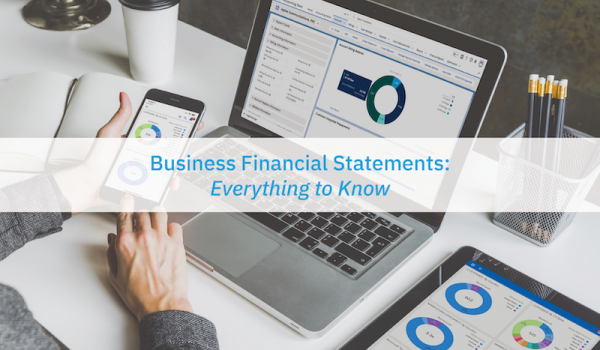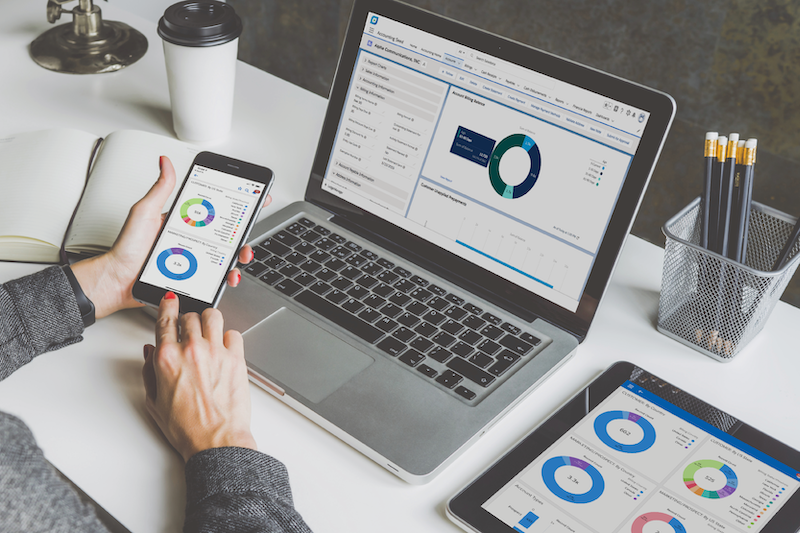
Is your cash flow enough to pay your staff next month? Have your debts accumulated until they’re larger than your assets? Just how much are your assets worth? Financial statements exist to give business owners answers to these questions. That’s why accurate financial statements are essential to business success.
You can create your own financial statements with relatively little fuss and expense, particularly through automating tools such as Accounting Seed.

Newsletter sign up
"*" indicates required fields
What is a Business Financial Statement?
According to the S.E.C., a business financial statement is a snapshot of your company’s financial health at a specific point in time. There are four main types of financial statements. They are the balance sheet, income statement, cash flow statement, and the statement of shareholder equity.
Here are some examples of financial statements:
-
- The balance sheet shows the value of your assets, liabilities, and the investors’ equity.
- The income statement reports your net income for a given accounting period.
- The cash flow statement covers how much money changed hands.
- A statement of shareholder’s equity is the difference between assets and liabilities.
Those examples of financial reports help businesses track business health and progress.
Why Create a Financial Statement?
When you make a financial statement, it becomes a window for you to see what’s going on in your company. Financial statements are also a valuable tool for investors. If someone’s considering putting money into your business, reading the financial statements can tell them if you’re a healthy company that will bring a good return.
Harvard Business School points out that the numbers on an income statement provide information of interest to investors, such as earnings per share, which is the company’s net income divided by the outstanding number of shares.
When to Prepare Financial Statements
Small businesses usually prepare financial statements at the end of an accounting period. Once you know how to put together a financial statement, nothing stops you from creating a small business financial document in the middle of a quarter or two-thirds of the way through the fiscal year.
Whether you want to compare Bad Debts to Accounts Receivable or evaluate your current cash flow, creating financial statements for your small business can provide the intel you need.
Writing a Balance Sheet
Many entrepreneurs feel intense pride when they talk about the value of their company. According to Harvard Business School, writing this financial statement tempers ambition and optimism with cool, rational numbers.
How to Create a Balance Sheet
To draw up a balance sheet, first decide what point in time it covers, such as the end of the second quarter. Then gather the necessary information.
1. List Your Assets
Assets include cash, accounts receivable, company vehicles, factory equipment, and inventory. Current assets include cash and anything easy to liquidate, such as inventory. Long-term assets — an apartment building or a copper mine for instance — are the ones that can’t be turned into cash so easily.
You have to set the dollar value for all your assets in your business financial statements, calculating them as accurately as possible. Then you add up the values to get the total for current assets, long-term assets, and finally total assets.
2. List Liabilities
Next come liabilities. Current liabilities are accounts payable and other debts you expect to pay off in the next twelve months. Long-term liabilities will be around for more than a year. Like assets, you set a dollar value on each individual debt and add them together to get your total liabilities.
3. List Equity
The third section of the balance sheet is owners’ equity. If you’ve issued, say, $50,000 worth of stock, that would be the equity. Add liabilities to equity and the result should equal your total assets. If the totals don’t match, there’s an error. Figure out where it is and correct your result.
Possible errors in this part of the balance sheet business financial statement include incorrectly entered numbers or mistakes in the inventory count. You may also find mistakes in currency exchange rates and miscalculated depreciation.
Learn more in the guide to Balance Sheets: Everything You Need to Know.
The Income Statement
In cash accounting, per the IRS, you only record expenses and revenue when money changes hands. With accrual accounting you record transactions when you earn money or incur an expense. If, say, you complete a job for $3,000, you report it in your ledgers immediately, even if the customer doesn’t pay for two months.
If your business runs on accrual accounting, you need both an income statement and a cash flow statement.
How to Prepare an Income Statement
The income statement measures total expenses against total income. You’ll need your total revenue for the period, both from sales and from any other sources, such as interest on loans or investments. You’ll also need your various outflows: purchases and other expenses, cost of goods sold, and depreciation.
At the top of the income statement, you report your gross sales. Then you subtract the cost of goods sold, then expenses, and you also add other income sources. At the bottom of this business financial statement you subtract taxes from the result to get your net operating income.
The Cash-Flow Statement
Even if your income is good, cash flow can be bad. If you’ve made several sales but the income from them is all in accounts receivable, you could find yourself without enough cash to pay the bills. It’s simple to get a handle on cash flow although it can be labor intensive. To do it, add up all cash payments received and subtract all the cash you’ve spent.
A less intensive but more complicated way to create a cash flow statement is to start with the income statement, delete all accrual income and expenses, and end up with cash flow. Say you’ve billed customers $30,000 that hasn’t been paid yet. You recognize that money on the income statement. Then you subtract it from total income as a step to determining cash flow.
Simplify Statements By Automating
If your accounting is up to date, you have all the information you need to draw up financial statements. But — do you have the time? At a successful company, adding up all the transactions for a month or even a week takes a lot of grunt work. On top of that, you have to figure depreciation, cost of goods sold, asset value and other key figures.
That’s a lot of sweat equity. Using automated software such as Accounting Seed reduces the effort involved when you make a financial report. Business financial statement generation becomes simpler with automation.
Automated Accounting Statements
If you use Accounting Seed to keep your ledgers, you can generate financial reports without any further setup, exporting them to Excel or PDF if you wish. Aside from the balance sheet, income statement, and cash-flow statement, Accounting Seed can generate other reports.
For example, you can create an automatic report comparing your income statement with your projected budget. It’s easy to compare accounting periods, such as last quarter and current quarter, and to use drag-and-drop to focus on particular data or customize your reports.
Accounting Seed makes it simpler to generate financial statements for small companies without huge accounting departments. Learn more in the guide to Accounting Automation: Benefits & How to Use It For Your Business.
Why You Need Business Financial Statements
Whether you use automation to put together your statements or you do it by hand, financial statements are a valuable tool. They provide a snapshot of how your business is earning, spending, and handling money. Over time they give you a simple way to compare finances quarter to quarter, month to month or year to year. Different statements provide different information.
Why You Need a Balance Sheet
The balance sheet shows how your assets compare to your debts. Too much debt is unhealthy, though “too much” is a tricky number to pin down. A company that takes out loans to buy construction equipment should expect a different debt-to-asset ratio than a web graphics company whose assets are a couple of laptops.
Why You Need an Income Statement
The income statement shows how you’re spending money, detailing how much you’ve earned and what’s happened to it. Going over the statement may reveal that your gross sales income is being nibbled away by a high rate of returns, interest on loans, or high overhead. Once you know the problems, you can set to work solving them.
Why You Need a Cash Flow Statement
The cash flow statement shows whether the money you have coming in is enough to cover expenses. If your income is high and your cash flow is low, it may be that you’re not collecting on accounts receivable fast enough.
Reading Your Business Financial Statements
There are two ways to read statements and gain a financial overview: horizontally or vertically.
-
- A horizontal analysis looks at trends over time, such as how earnings per share have changed over the past three quarters.
- Vertical analysis compares different figures on the same report. For instance, how much of your cash flow went to payroll, to overhead, or to buying raw materials?
Using Good Financial Judgment
To make good use of your statements you need good financial judgment. There are many points where accurate accounting requires judgment calls, such as figuring out the value of your assets.
The fair market value of your equipment, for instance, can make a difference to your debt to asset ratio. That makes it tempting to pick the biggest value allowed by accounting rules. Deciding how much of the income in accounts receivable is really a bad debt makes a difference to the balance sheet too.
Managers may tend to game the income and cash flow business financial statements without doing anything fraudulent. If quarterly income looks bad, postponing necessary purchases until next quarter can make it look better. You should be aware of potential weaknesses when you go over the statements and be willing to dig down into the details to clarify any questions you have.
How to Use Financial Statements
Suppose you’re concerned because the annual balance sheet shows you’re carrying an extremely high debt load. You might first research whether companies in your industry normally carry a high level of debt, and how you compare to your competitors. Then you have to ask if the debt level is sustainable.
If there’s an economic downturn ahead, will you still have enough revenue to service the debt? Are interest rates likely to rise? Should you prioritize paying off some of the debt early?
Statements and Dashboards
If you’re concerned about the fine details — where exactly does most of your sales income come from? — Accounting Seed makes finding answers easier thanks to its customized financial dashboards. With the software automatically updating the general ledger when money is coming in and out of the business, the dashboards show the information you most want to know in real-time.
Working from a dashboard also makes it easy to dig down into the data and learn the details of any underlying transactions. This kind of granularity can surface issues and avoid nasty surprises in periodic business financial statements.
Use Accounting Dashboards to Drive Deep Insights
Choosing the right dashboard simplifies the process of turning large, bulky amounts of data into something visually understandable.You can take the dashboard information and use it to create reports and better presentations, analyze business performance, and review useful statistics, metrics, and benchmarks.
Making use of Accounting Seed’s automated accounting software simplifies your accounting processes and makes it easier to mine your ledgers for deep, business-driving insights.
Looking for more helpful financial tips for your business? Read on:
- Top 7 Issues Accountants Face Today
- Accounting Cybersecurity: How to Keep Financial Data Safe and Secure
- Best Vendor Payment Processes for Your Business
- DCAA Compliant Accounting Software: What to Look For
- What are the International Accounting Standards (IAS)?
- Top 8 Reasons Why IT Implementations Fail
- What is Cash Disbursement in Accounting?
- Accrued Expenses: What Are They And How to Report Them?
- Intro to Accounts Payable and Purchase Order Accounting
A native Salesforce accounting app, Accounting Seed, provides a full 360-degree view of your business’ performance to help you and your team make the best decisions possible. Not on Salesforce? Our software can be customized to work with any system you have through a reliable connection.
See Accounting Seed in action
Get a close-up view of how accounting on Salesforce can eliminate the need for costly integrations—and silos of mismatched information—by sharing the same database as your CRM.



